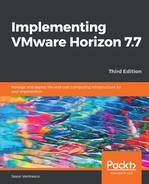Windows Sysprep is a utility included with the Windows operating system that is used to personalize a Windows image. Rather than install Windows on each machine individually, organizations can apply a preconfigured image to a machine and then use Sysprep to generate the identifiers that make that installation of Windows unique.
When deploying linked clone desktops, you have the option of using Sysprep or the included VMware QuickPrep tool to customize the operating system. The tools do not perform all of the same tasks, so it is important to understand what differs when you choose one over the other.
The following table details the differences between Sysprep and QuickPrep:
| Task | QuickPrep | Sysprep |
| Change security identifiers on the parent image | No | Yes |
| Change the computer name | Yes | Yes |
| Join the new virtual machine to the domain | Yes | Yes |
| Remove local accounts | No | Yes |
| Remove parent image from the domain | No | Yes |
| Reuse preexisting AD computer accounts | Yes | Yes |
| Generate a new System Identifier (SID) | No | Yes |
| Update language, regional, data, and time settings | No | Yes |
| Reboots required | 0 | 1 |
| Requires a configuration file and Sysprep utility | No | Yes |
It is important to consider the differences between Sysprep and QuickPrep when determining which method to choose. In some environments, it may be that QuickPrep cannot be used because it does not generate a new SID for the guest operating system. In other environments, it may be that there are no issues with using QuickPrep. Generally speaking, QuickPrep enables faster desktop deployment, which affects not only desktop pool creation but recompose operations as well. Regardless of which method you choose, it is important to monitor the behavior of the desktop during a pilot program to ensure that the desktops are functioning as expected.
